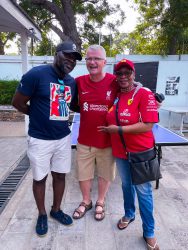Brands are the imagery of products. Every product, I would say, is made up of three parts: spirit, soul and body. The spirit is mostly referred to as the life-giving part of a man. In product terms, I refer to the brand as the ‘spirit’. A product’s acceptability and continuous demand makes it a force to reckon with. What makes a brand more pronounced is the speed at which it spreads locally and internationally. Sometimes, the dynamics of local and international acceptance of a product are a mishmash to consumers. Making a brand international with a market share and profitability is a dream for many manufacturers and service providers. However, this feat cannot be attained without dynamic marketing strategies, carefully implemented.
There are brands that do not do so well in their home country but do extremely well internationally. This is contrary to the general norm, that a brand must first be accepted in its home country before it can be accepted internationally. Some brands’ managers came to learn painfully long after the failure of their brands in their home country that the activities of competitors – which can be referred to as ‘kangaroo’ marketing – are to blame for their brand’s failure. Many have learnt from their mistakes, and are approaching their brands in ways that will establish them firmly in the market.
Continuous marketing education, activities of successful as well as failed brands give guidelines to building brands differently from the past, and also contextualising the brand attributes to suit consumers of various backgrounds. This means that everything that goes into the brand-building is approached with the consumer’s preference in mind.
In view of this new knowledge, brands that are approached rightly are growing very fast and spreading widely; particularly Internet-driven brands like google, WhatsApp, Facebook, mobile money and what have you. It would not be surprising if in the near-future we see new brands growing and spreading likewise. The continuous bright future is technology-driven businesses; therefore, businesses that are not technology-driven will take long to make a global impact – and as to whether that business will become known globally is another argument.
I will quickly put it forthrightly that doing global business is not for everyone. As much as some businesses would like to grow exponentially, others are just happy remaining at the small local level. Whatever the aspirations and strategy of the local business are, their practice assumes that is where they want to be; and businesses that aspire to global reach have also embraced the motivation and foresight to grow their brand internationally.
Whichever way you want to approach your business, embracing these five and a half attributes will make your brand more relevant than leaving it to chance. The following paragraphs will expatiate on the five and a half attributes of successful brands as:
- Idea
Reality starts from the mind. The products offered to us daily were first abstract thoughts or ideas in the mind of someone. No successful brand can be achieved without an idea. An idea must be clothed with planning, implementation and continuous improvement. People who have ideas for successful brands are driven by passion for the idea and an indomitable will to succeed no matter the challenges they encounter. In the lyrical words of Robert Nesta Marley, “Where there’s a will, there’s always a way”. Perhaps this inspirational saying of Robert Nesta Marley is for all who desire to own a successful brand.
Passion for success transcends age, educational qualification, experience, start-up capital – and perhaps family background. Failure may be precipitated when one’s idea is subject to over-analysis, thereby paralysing the idea which therefore cannot be implemented. Usually the ‘not to do’ voice is louder than the ‘to do’.
Passion and an indomitable will to succeed is what made Adidas a global successful brand. Founded by Adolf Dassler at a mere 20 years of age, he birthed the idea of sporting shoes which has now expanded to many other sporting goods. Adidas developed its products to provide extreme comfort for sports people, and promoted them through prominent athletes like Muhammed Ali, and major world sports activities like the Helsinki Games.
The brand went into global expansion with new product designs for the leisure and clothing sector, providing more comfort for users. They also introduced the three-stripes logo around the same era. The three-stripes logo since then continues to be a global logo of prestige and easy recognition. In a bid to expand their investment and global reach, they went into acquisitions of other sports companies.
Adidas’ slogan “impossible is nothing” shows that an idea coupled with passion and indomitable will can make a brand successful.
- Start it
An idea that is not started or has no action in its direction continues to remain in the head. All successful brands started based on motivation driven by passion. The founders of successful brands’ passion were not merely driven by financial gain. They had more to their motivation than money. The passion was for what they do or what they wanted to do – i.e. their products. Interestingly, passion-driven brands that are carefully worked on yield success which in turn brings the founders much more money than was even expected. In effect, when you put the brand first, money will definitely follow.
Just start it, and start it right. Whether you are the business’s founder or you inherited it, your induction into office is an opportunity to start. Many start for different reasons, but a passion-grounded start will more often than not yield good returns.
In the illustrious instance of Harland Sanders, he started Kentucky Fried Chicken (KFC) at age 56 years, having gone through life as a farmhand, rail operator, justice of peace and insurance salesman. His passion to build a global brand never waned, despite several restaurants turning his spices down. He started KFC doing what he liked best – cooking.
Sanders worked hard enough, and usually founders of successful brands at the start have their families involved in the business. Let me hasten to add here that families are important for creating successful brands. Sanders went global by inviting partners to invest into the business. Expansion of your brand through investors is only possible when the business is doing well and they see the potential for growth. A brand cannot be so successful if it only stays in its home country. Thus, it is important that every local business strives for the international or global stage.
Though KFC became so successful in America, there was a need to go global – hence the expansion by inviting investors. Mergers and acquisitions is another strategy in growing successful global brands. In the case of KFC, its successful brand strategy was also gingered by the merger with food and alcoholic beverage company Heublein Inc. The merger failed at a point, which also gives insight that merging with other brands must be carefully considered before entering – and you must know when to step out.
- Being the first
Being the first to venture into a business comes with an advantage. There is less competition which gives room for higher market share. In Ghana, Joy FM and Peace FM maintain a significant lead in the private radio business arena due to the principle of being the first to venture into a business. Same with TV3 as one of the first in privately owned television broadcasting. While many have enhanced their brand success by taking the first-mover advantage, others though had the first-mover advantage yet did not do much to capitalize on it. Thus, did not fight to build their brands from a local to a global level.
The significant lesson is that as much as being the first to establish in a sector, it is more important to be a better first than just to be first. By pushing hard to maintain your brand through best practices you can move from being the last established to first-mover advantage.
- They had an idea
- Why they started
- Being the first advantage
- Funding
- Going international
- Continuous improvement










